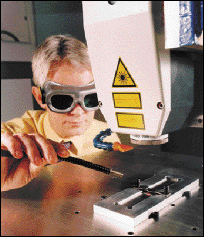Jacqueline D. Paige
Researchers have devised a laser technique that bonds thermoplastics without using environmentally unfriendly pretreatments. The method -- developed by the Warwick Manufacturing Group at the University of Warwick -- promises to take less time and money than other laser- and nonlaser-based methods.

Researcher Tony Hoult sets up his laser process to bond two pieces of plastic.
Although the use of lasers to bond plastics is not new, most of the progress has been made in bonding polycarbonate plastics. With polypropylene-type materials, manufacturers often shy away from new laser bonding technologies because they lack power or use complex, expensive devices such as CO2 or solid-state lasers.
The new laser bonding technique developed by Tony Hoult, a researcher at the university, uses a compact 1.2-kW infrared diode laser purchased from Rofin-Sinar Laser GmbH of Hamburg, Germany, for £60,000. The laser was designed for use in soldering, brazing and other surface treatment processes. However, Hoult discovered that the high-power diode laser is well-suited to a wide range of plastics-joining techniques. "Its performance has exceeded our expectations," he said.
The technique bonds plastics and reinforced engineering pla stics without disfiguring pretreatment. Unlike other laser-based plastic welding techniques, it enables a range of plastics, plastics to rubber, plastics to foams, and foams to foams to be bonded even if they are not transparent. With other technologies -- which have not made use of infrared wavelengths -- at least one of the plastic components must be transparent so that the laser light will pass through to their interface.
Another benefit of Hoult's technique is that the laser head is small -- about the size of a car vacuum -- and easy to use, allowing it to be directly mounted on small assembly-line robots.
Traditional nonlaser bonding methods for polypropylene have proved unsatisfactory. They typically use environmentally unfriendly chemical pretreatments or heat-based treatments that are not always consistent, and the bonding can be very weak.
Hoult is still refining his joining process to make it more suitable for specific industrial applications. "In five years' time, I can see these types of lasers being commonly used in this type of application and others," he said.
